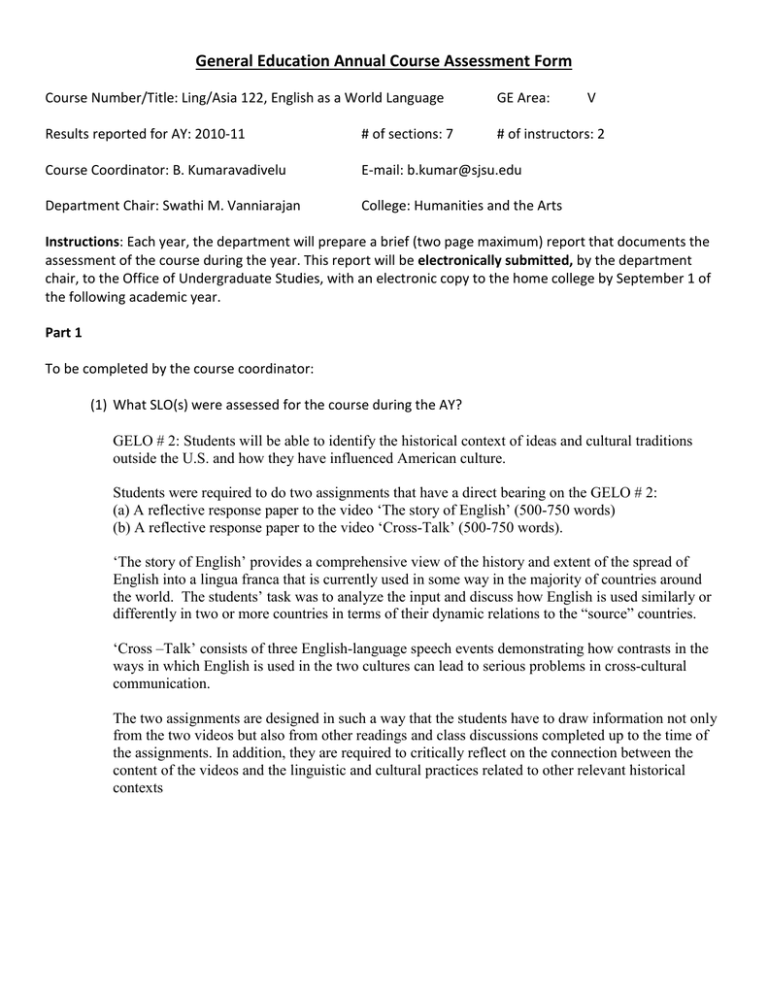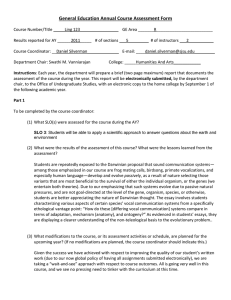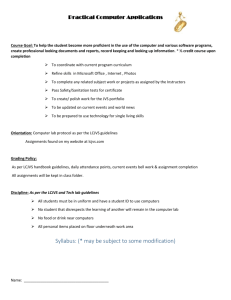General Education Annual Course Assessment Form
advertisement

General Education Annual Course Assessment Form Course Number/Title: Ling/Asia 122, English as a World Language GE Area: V Results reported for AY: 2010-11 # of sections: 7 # of instructors: 2 Course Coordinator: B. Kumaravadivelu E-mail: b.kumar@sjsu.edu Department Chair: Swathi M. Vanniarajan College: Humanities and the Arts Instructions: Each year, the department will prepare a brief (two page maximum) report that documents the assessment of the course during the year. This report will be electronically submitted, by the department chair, to the Office of Undergraduate Studies, with an electronic copy to the home college by September 1 of the following academic year. Part 1 To be completed by the course coordinator: (1) What SLO(s) were assessed for the course during the AY? GELO # 2: Students will be able to identify the historical context of ideas and cultural traditions outside the U.S. and how they have influenced American culture. Students were required to do two assignments that have a direct bearing on the GELO # 2: (a) A reflective response paper to the video ‘The story of English’ (500-750 words) (b) A reflective response paper to the video ‘Cross-Talk’ (500-750 words). ‘The story of English’ provides a comprehensive view of the history and extent of the spread of English into a lingua franca that is currently used in some way in the majority of countries around the world. The students’ task was to analyze the input and discuss how English is used similarly or differently in two or more countries in terms of their dynamic relations to the “source” countries. ‘Cross –Talk’ consists of three English-language speech events demonstrating how contrasts in the ways in which English is used in the two cultures can lead to serious problems in cross-cultural communication. The two assignments are designed in such a way that the students have to draw information not only from the two videos but also from other readings and class discussions completed up to the time of the assignments. In addition, they are required to critically reflect on the connection between the content of the videos and the linguistic and cultural practices related to other relevant historical contexts (2) What were the results of the assessment of this course? What were the lessons learned from the assessment? The following Table presents a summary of results (Total number of students = 177). Assignment ‘The story of English’ ‘Cross-Talk’ Grade A Grade A- Grade B+ Grade B 53 (30%) 70 (40%) 34 (20%) 44 (25%) 27 (15%) 23 (13%) 42 (23%) 32 (18%) Grade Below B 21 (12%) 8 (4%) The results showed that most of the students learned what they are supposed to have learned in doing the two assignments and in reading extra materials needed to do the job well. Thus, the desired learning outcome in relation to GELO # 2 seems to have been achieved. Lessons learned: We learned that (a) student-led discussions in-class would contribute notably to a deeper understanding of the issues raised in the videos, (b) relating some of the historical developments to contemporary issues that the students are familiar with might enhance their motivation to pay greater attention in class, and (c) they needed additional readings in identifying and analyzing problematic aspects of cross-cultural communication. (3) What modifications to the course, or its assessment activities or schedule, are planned for the upcoming year? (If no modifications are planned, the course coordinator should indicate this.) Based on what we learned, we would like to allot time for and organize more student-led discussions of topics that arise from the classroom inquiries. Secondly, we feel it might be beneficial for students to read articles that we did not recommend them to read. For instance, Tannen’s ‘Framing and Reframing’ would be a good choice. We intend to ask the students to read this article before the videos are viewed, and discuss the video content in terms of Tannen’s insights into cross cultural communication. Part 2 To be completed by the department chair (with input from course coordinator as appropriate): (4) Are all sections of the course still aligned with the area Goals, Student Learning Objectives (SLOs), Content, Support, and Assessment? If they are not, what actions are planned? Yes. The two instructors have collaborated with each other very well in aligning the area Goals, SLOs, Content, Support, and Assessment in their teaching and assessment. The assessment instruments and the teaching materials are nearly the same. As it is reported, making provision for one more reading materials for the students to reflect on will enhance the overall instructional value of the course. The two instructors will be asked to work on this in Fall 2011.
![[Course information: prefix, number, title, credits] GENERAL EDUCATION COMPETENCY AREA:](http://s2.studylib.net/store/data/015759506_1-897e653fa9d8b4d146755dfb01d20713-300x300.png)

